The Dating of the Coinage of Alexander the Great
by Zoë Sophia Kontes
Alexander the Great, only twenty years old when he became king of Macedonia in 336 B.C., was perhaps the greatest general of all time. He was certainly a great empire builder. In the course of just thirteen years before his death at Babylon in 323 B.C., he changed the Mediterranean and Near Eastern world forever by bringing the territory of the Persian Empire under Greek rule. This vast region stretched from the borders of India and inner Afganistan in the east to the Adriatic Sea in the west and from Egypt in the south to the coasts of the Black Sea in the north. The Hellenistic Near East and the Hellenistic world beyond the Near East were the product of Alexander's adventure. The repercussions of his reign were thus profound, and nowhere more so than in the history of money. Alexander's coins, the most familiar being the silver issues bearing a head of Herakles on one face and a seated Zeus with the king's name on the other, were struck throughout the empire. (1)
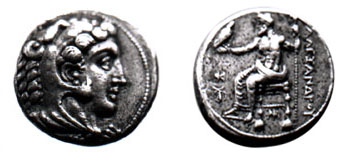 |
| Silver tetradrachm (17.28 gm.) diam. 2.5 cm., Brown University Collection, gift of Capt. John R. Lewis. |
Such coins were not only minted during Alexander's lifetime but their issue was continued in the two decades following his death by the Macedonian generals who divided the empire between them and created the Hellenistic kingdoms. Even as the successor kings initialed coinages in their own names and with their own types the "Alexanders" lived on for two centuries during which time they were issued by independent cities as an international coinage.
Today "Alexanders" still exist by the thousands. Their very number, however, and the large array of monograms and symbols used to identify the mints where the coins were struck and the mint officials who supervised the work, make this one of the most challenging series for the numismatist. A Sir George Hill wrote in 1909: There are few series which present more difficulties in the way of chronological classification than the 'Alexanders.' The mass of material is so vast and the differences between the varieties so minute, so uninteresting to anyone but the numismatic specialist, and so difficult to express in print, that very little progress has been made since the publication of L. Müllerr's remarkable work in 1855. . . (2)
But at that moment the study of the Alexander coinage was about to be revolutionized by a young American collector and scholar, Edward T. Newell. Newell graduated from Yale in 1907 and took an MA two years later. He always remained a private scholar, laboring in his work rooms at the American Numismatic Society in New York where his collection of Greek coins today forms the backbone of the Society's world-famous collection. After his premature death in 1941, his obituary in the American Journal of Archaeology characterized him as "America's greatest numismatist."
To understand the revolution in our knowledge of the coins of Alexander's lifetime and the posthumous Alexander's that began with Newell's Reattribution of Certain Tetradrachms of Alexander the Great of 1911 (3), one must go back to the mid nineteenth century. Ludvig Müller, to whom G.F. Hill was referring in the quote above, was a Danish scholar whose work of 1855, Numismatique d'Alexandre le Grand, suivie d'un appendice contenant les monnaies de Philippe II et III, was the first comprehensive study of the coinage. Müller was able to distinguish between the early and later coins of Alexander by examining the size of the flans, which no scholar had previously done. His observation that the flans became progressively wider and flatter was an indication of evolvement over time, thus he was able to establish a general chronology.(4) In addition, Müller carefully studied the reverse symbols and ligatures found on nearly all of the coins, and assigned them to mints accordingly. While accepting the possibility that they might refer to different magistrates as opposed to mints, he believed that this was not the case. His theory was in fact plausible, since there are indeed some reverse marks which do repeat well-known city types. For example, posthumous issues marked with a sphinx are attributed to Chios, while those with a lion looking back at a star were minted at Miletus.(5) Though Newell's work, based on a far larger corpus of coins than Müller knew called into question the general approach of his predecessor, many of Müller's mint attributions remain uncontested today.(6)
Newell utilized the technique of identifying coins struck from a common die (called "die linkage") to show that coins attributed by Müller to different mints were, in fact, the products of the same mint because they shared a common obverse die, even though the symbols and monograms of their reverses were different.(7) The main body of evidence that permitted Newell to achieve the reconstruction of the minting of the Alexanders was the Demanhur hoard. This cache of over 8,000 Alexander tetradrachms was found in Egypt in 1905. Newell himself originally came into possession of some 400 of these, and had personally examined over 2,000 for his discussion of the coins in Reattribution. By the time he published Alexander Hoards I2. Demanhur, 1905(8) in 1923 he had compiled, from his own collection and other sources, a record of close to 6,000 coins from the hoard. On the basis of his observation of die links, he divided the tetradrachms into eleven groups, each of which had 3-12 different control marks.(9) Such control marks on Greek coins are often interpreted as identifying officials responsible for a particular issue. In Newell's system, relying on the objective evidence of the obverse die links, it was apparent that they had a similar function in the Alexander coinage.
Tetradrachms, of course, formed only a part of the Alexander coinage, and this is the time to review all the types in silver, gold and bronze. All of the coins were minted on the Attic standard (unlike his father's coins, of which only the gold was of Attic weight, while the silver was struck on the local Macedonian standard).(10) The following are the most common types.
For the gold, obverse: Athena wearing crested helmet decorated with serpent; reverse: Nike standing facing left, holding wreath in extended right hand, stylis (a naval standard) in left, vertical legend ALEXANDROU.
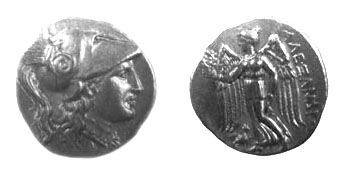 |
| Gold stater (8.67g) diam. 1.8 cm.,Museum of Art Rhode Island School of Design, ex Henry Augustus Greene. |
For the silver (tetradrachms and drachms), obverse: head of Heracles wearing lion skin facing right; reverse: Zeus seated on throne facing left, holding eagle in outstretched right hand, scepter in left, vertical legend ALEXANDROU.
 |
| Silver tetradrachm (17.11g) diam. 2.5 cm., Brown University Collection, gift of Capt. John R. Lewis. |
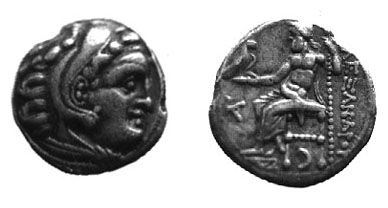 |
| Silver Drachm (4.09g) diam. 2.0cm.,Brown University Collection. gift of Capt. John R. Lewis. |
The bronze unit has, obverse: head of Heracles in lion skin facing right; reverse: bow in case and club, legend ALEXANDROU.
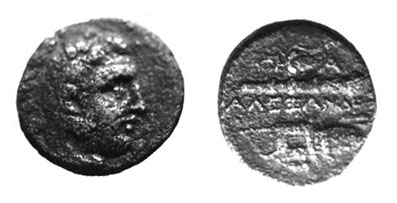 |
| Bronze unit ( 6.03 g.) diam. l.8 cm., Brown University Collection. |
Alexander's coinage continued to be struck after his death in 323 B.C.. His immediate successors continued to use his types, although eventually substituting their own names for that of Alexander. Both lifetime and posthumous Alexanders were struck in Macedonia, as well as in mints throughout the empire. During Alexander's lifetime, twenty-five mints were producing his coins: two in Macedonia, one in Egypt, and twenty-three in Asia.(12) In the years immediately following his death that number increased to thirty-one, possibly including a Peloponnesian mint at Sicyon. In the last quarter of the third century, over a hundred years after his death, fifty-one mints were still producing Alexanders, mainly the tetradrachms.(13) Thousands upon thousands of these coins are extant, found in a multitude of hoards. Approximately forty-six hoards containing silver and thirteen containing gold from the main mint in Macedonia have been documented in greater or lesser detail.(14)
Newell divided the Alexander tetradrachms into groups, and assigned his groups the letters A-K, basing his chronology on style, die links between groups, and the addition and subsequent removal of the title BASILEOS to the coinage. This title appeared first on coins of Babylon around 325 B.C., became widespread, then disappeared just a few years later. The basis for putting group A first was that this group's reverse control marks include some also found on coins of Philip II: a prow, stern, janiform head and sometimes a rudder.(15) His hypothesis is still accepted today. In addition, he was now able to offer conjectures about mint location on a new basis. The late Philips (Georges Le Rider's Group II B, see footnote 15) were closely die linked, indicating to Newell that indeed they must be from the same mint. Since Philip's lifetime coins were most likely only minted in Macedonia, the earliest Alexanders, group A, must have also been minted there. Newell placed the first Alexanders in 336 B.C., at the beginning of the reign. Newell's chronology depended on evidence from the great Demanhur hoard in another respect. In this hoard were found Alexander coins bearing dates. These are the coins minted at Sidon and Ake where issues made before Alexander's conquest bore Phoenician numerals dating the coins according to the regnal year of the local king. Alexander's issue continued this system.(16) During the siege of Tyre Alexander had his base in Sidon, which had a well-established mint. In addition, Alexander was in possession of great sums of money seized from the Persians at the Battle of Issus. These two factors, along with the necessity of clearly establishing himself as the leader of a new empire, immediately led to the minting of coins. Two Alexander coins of Sidon bear Phoenician letters which signify Year 1 and Year 2. These first two years of the Sidonian era refer to either the first two years of Alexander's power in Asia Minor (beginning with his success at Issus) or the rule of the local king Abdalonymos, whom Alexander appointed at this time. These would have been the years 333-332 and 332-331.(17) Thus, the inauguration for the minting of these Alexander coins at this time is historically appropriate, and supported by numismatic evidence. The dated obverse dies of the tetradrachms of Sidon and Ake continue until 319/318 B.C., giving us a fixed point for the lifetime and early posthumous coinage of Alexander up to that year.(18) Newell's chronology for these coins has stood the test of time and is not likely to be affected by any further discoveries. However, his dating of the actual beginning of Alexander coinage overall to 336 B.C., long accepted by most scholars, has become the subject of great debate.
In his "Alexanders Reichmunzen" of 1947 Gerhard Kleiner proposed that Alexander did not begin to mint his own coins at the beginning of his reign.(19) He contended that the young king did not take this step until 331 B.C., two years after the Battle of Issus, and that he did so at Tyre, upon his return from Egypt. In the meantime Alexander relied on the continued minting of coins of his father Philip and his own so-called 'eagle' tetradrachms, augmented by existing coins of Athens and Persia. Kleiner's theory was based on the style of the seated Zeus on the reverse of Alexander's silver tetradrachm, which he argued was derived from Cilician coinage minted under Mazaeus, the most recent Persian satrap.(20) In arguing these lower dates, he had to amend Newell's dating of the coinage of Sidon and Ake from 333/332 to 331, an amendment that would later prove to be incorrect(21). His ideas were generally dismissed at the time, but more recent scholars have revived his work, with additions of their own. We will leave Kleiner for now, to continue with our chronological study, but the debate over the dating of the Alexanders, begun by him, is probably the most highly contested and engaging question regarding the current study of the Alexanders.
In 1955 Margaret Thompson and Alfred R. Bellinger published a work detailing the Alexander drachms of Asia Minor.(22) While Newell had included drachms in his study of this coinage, the tetradrachms were not his main focus. Thompson and Bellinger's work was the first of its kind, and made clear a fact noted by Newell: Alexander's mints had different functions. Some mints, principally the seven discussed in their work, were established for the express purpose of minting small silver for the empire, while others, particularly those in Macedonia, were responsible for the larger coinage. Thompson and Bellinger proposed that this was not an arbitrary system set up by Alexander, but a logical progression based on existing local coinages. Persian sigloi, not minted on an Attic standard, were commonly used in Asia Minor. Therefore the drachm, rather than the tetradrachm, would have been more familiar means of exchange for the people of this area.(23) The drachms were a significant part of the overall coinage, and their sequences are entirely separate from the tetradrachms. Thompson and Bellinger established the arrangement of drachms from the seven main mints (along with the staters associated with them (24)) based on the close die links among the coins. They used three important dates as the backbone of the chronology for this arrangement: 334, the year in which Alexander began his campaigns in Asia Minor, 323, the year in which he died, and 317, the death of Philip III. None of the Alexander drachms of Asia Minor can have been produced before 334, any coins that bear Alexander types but the name of Philip III must be after 323, and no coinage of Philip III can have been minted later than 317 .(25) This study added an important piece to the overall study of Alexander's coinage, in organizing the coinage as well as providing the basis for determining its chronology.
In 1977, Georges Le Rider published a first and only comprehensive study of the coins of Philip II, Alexander the Great's father. (26) This work established the chronology of Philip's coinage, and in doing so provided a new perspective on the history of Philip's reign in general. Philip's large gold coins were struck on an attic standard and began late in his reign (according to Le Rider), with obverse: laureate head of Apollo facing right; reverse: Nike in a chariot drawn by two horses, with the legend PHILIPPOU. A fractional issue had obverse: head of Herakles r. and reverse: kantharos, bow and club, with the legend PHILIPPOU. The large silver denomination was struck on the local Macedonian standard of approximately 14.52g, with obverse: laureate head of Zeus facing right. The reverse had two forms. Between 359 and 348 it showed horseman facing left with kausia, raising right hand in salute, PHILIPPOU. The second reverse struck between 348 and 336 was jockey facing left with palm branch, PHILIPPOU. The Philip coinage also included bronze units with obverse of a young head with taenia, and reverse of a horseman with the inscription PHILIPPOU.
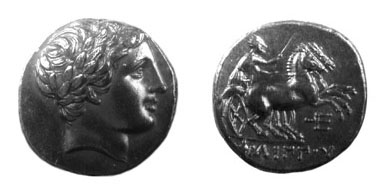 |
| Gold stater (8.63 g.) diam. 1.8 cm. Museum of Art Rhode Island School of Design, ex Henry Augustus Greene. |
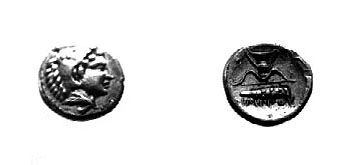 |
| One quarter Stater (2.50 g.) diam. 1.1 cm., Brown University Collection, gift of Capt. John R. Lewis. |
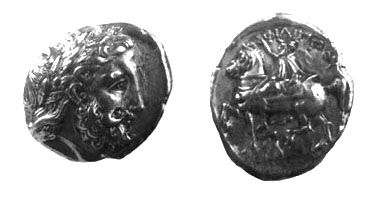 |
|
Silver tetradrachm (14.34 g.) diam. 2.5 cm. Museum of Art Rhode Island School of Design, ex Henry Augustus Greene.
|
Le Rider set the beginning date for Philip's silver coinage at his accession of the throne in 359 B.C.. He divides the coinages into two series, the first commencing in 359 at Pella, and the second in 357 at Amphipolis.(28) The striking of both series continued until 329/8, (although perhaps with a brief cessation in 336) then resumed again c. 323/2, after the death of Alexander. The posthumous issues at Pella continued until c. 315/4, while those at Amphipolis were struck all the way until 294 B.C., when Demetrius Poliorcetes began striking his own types. Le Rider places the first striking of the gold issues later in Philip's reign, perhaps 345 B.C. or even as late as 342. He asserts that like the silver, the gold stops in 329/8, and resumes in 323/2.(29) At both mints, the gold was last minted around 310. Le Rider's dates are important to our study of the dates of Alexander's coinage. If Philip's coinage was being minted in 336 B.C., then either the two were minted simultaneously, or Alexander did not start minting until later. If the silver did stop for a bit in 336, (perhaps due to Alexander's short lived eagle coins) while the gold continued, this perhaps can be explained by the fact that the gold was minted on an Attic standard, as were Alexander's coins. Le Rider argues that if the coinage of Philip did not stop immediately upon the minting of the new Alexanders, then it was not long afterwards. He provides as evidence the fact that the common symbols shared by the two issues (prow, stern, janiform head, rudder) do not occur again in Alexander's lifetime. Yet he mentions a group of Philips which have all the same symbols with the addition of a bee, hinting perhaps that this group continued later than the others.(30)
In 1982, Orestes Zervos discussed Alexander's earliest coins, championing Kleiner's theory of a lower date, which had been for the most part dismissed. His article was essential in that it posed a serious challenge to the traditional dating system worked out by Newell, spurring much discussion among scholars. As of today, opinion is quite divided on the subject; there are as many proponents of low dates as high. This was not the case after Kleiner's article was published, and Zervos deserves the credit for being the first to provide successfully an alternative to a well-established tradition.(31) In his article Zervos argues that while difficult to comprehend, Kleiner's argument was essentially correct. He reorganizes and explains Kleiner's ideas, corrects them as necessary and provides additional evidence for his theories. Zervos emphasizes not only the iconographic but also stylistic characteristics of the early Alexander coins, and provides sufficient numismatic evidence for his proposals. Kleiner had not done this, having based his dating system on iconography and history, and having attempted to alter the numismatic evidence to suit his theory by lowering the date of the Sidon and Ake coinage.
Zervos principally details Kleiner's theory regarding the silver tetradrachms.(32) Kleiner argues that the seated Zeus type on the Alexander tetradrachms was based on the Cilician type of the Baal of Tarsus, which implies that Alexander (or his officials) had seen these coins before minting his own. Because the figures of Zeus of the earliest Alexander coins of Tarsus and the earliest of Amphipolis are so similar, Kleiner argues that the Baal minted by Mazaeus was the prototype for the Zeus at the same mint for coins issued by Alexander, and from them the Zeus of Amphipolis was derived. In other words, the Alexander coins were first minted in Tarsus, and minting in Amphipolis began subsequently. Zervos outlines five characteristics of the coins showing eastern ('oriental') origin in style. These five characteristics are: 1) the figure's legs fixed stiffly together, 2) the unnatural position of the hand extended and holding the eagle (all fingers visible), 3) the awkward twisted position of the torso, 4) the large roll of drapery at his waist, and 5) the design of the throne on which the figure sits (particularly the 'bellcovers' on the legs).(33) These eastern elements are found on the earliest tetradrachms of Amphipolis, in contrast, Zervos claims, to the classical styles of the local Macedonian coinage of the time (the Alexander gold coinage as well as the posthumous Philip II gold). With regard to the obverse head of Heracles, Zervos agrees with the traditional theory that this type was derived from the Heracles used on the coins of Alexander's predecessors. Yet he does not believe that this contradicts his theory; rather he explains the types as having been introduced separately at Tarsus and Amphipolis. Used first at Tarsus to compliment the Zeus reverse, when later adopted at Amphipolis, the head was an independent continuation of Macedonian type in a local style unconnected to the iconography at Tarsus. Therefore since the two types are decidedly distinct, the style of Heracles cannot be used in argument against the lower dating system.(34)
Zervos provides evidence from three hoards containing Alexander tetradrachms. First, the hoard of Kyparissia, whose burial Newell dated c 328-327 B.C.(35), contains more Amphipolis tetradrachms than those of Tarsus. Previous scholars had argued therefore that Amphipolis must have been minting first. Zervos believes that this is not necessarily true, as Amphipolis produced more coins in general. Secondly, in examining the Demanhur hoard, he argues that as Newell described them, a greater percentage of the Tarsus coins than those of Amphipolis were worn. Thus, Tarsus had been minting prior to Amphipolis. Thirdly, in the small hoard of Mageira, thought to be the earliest hoard containing Alexander coins, only one lifetime coin was foundaó tetradrachm from Tarsus.(36) Zervos, while admitting that none of these hoards provides solid evidence, they at least cannot be used to contradict his theory.(37) Next taking Alexander's gold into consideration, Zervos is able to correct Kleiner's original hypothesis that the beginning of the Alexander coinage came in 331 after the fall of Tyre. This seems to have been Kleiner's chief confusion, which was based on the gold types.(38) Kleiner regarded the obverse of a helmeted Athena (with reverse of a Nike holding a wreath and stylis--a naval standard, a cause for much discussion among modern scholars as to its 'Panhellenic' reference), as representing naval activity. Therefore, because of the stylis, he dated the coinage to after the Battle of Tyre (where Alexander did in fact use ships). As he did not separate the commencement of the gold minting from that of the silver, he dated both to 331. In order to make this date feasible, however, Kleiner had to lower the dating of the coinage of Sidon and Ake, established by Newell in 1916 as beginning in 333/2, in order that the Tarsus coins would be the first. Zervos argues that because of the common coin types at both mints, the coinage must have been planned in Macedonia and in Tarsus, and since the silver was based on the Tarsus silver, the gold too must have been minted later than the Tarsus silver.(39) If this is the case, then the beginning of the silver coinage can be dated to 333 B.C., after the battle of Issus. More importantly, the date concurs with the evidence of the dated coins of Sidon and Ake, which Newell found to have begun in 333/2.
Zervos's theories were questioned by Martin Price, and the two scholars amicably published their views side by side in the Numismatic Chronicle of 1982.(40) In examining the characteristics common to the Zeus of Tarsus and the Zeus of Macedonia, Price finds that each of them could have been introduced on the coinage independently in Macedonia. The styles used are not uniquely 'oriental,' and all have precedence in earlier Greek coinage. In particular, he argues that the outstretched hand is not an unnatural pose at all, but one proper for holding a bird. The hand is depicted in this manner at the main Macedonian mint during Alexander's lifetime, while at another significant mint the hand is rendered more 'classically,' or naturally. But, as Price argues, the 'unnatural' pose must have been acceptable to the classical aesthetic as well, and had been presumably prescribed by Alexander or the controller of his coinage, only changing after the king's death.(41) Price also argues against the hoard evidence given by Zervos. He asserts that Zervos's interpretation of the evidence of wear in the Demanhur hoard to mean that 46% of the Tarsus coins were struck before 81% of the Macedonian coins is faulty. It merely indicates that the hoard contained a large number of late lifetime and early posthumous Alexanders. Price maintains that Alexander began minting his silver coins immediately upon becoming king. Three years later, in 333 B.C., he set up a new mint in Tarsus after his success in the Battle of Issus. Tarsus was an administrative center close to Issus, and his mint was established at the mint which had been used by the Persian satraps of Cilicia. At this point, as is accepted by scholars in general, eastern influence can be seen on the Alexander coins, since the die-engravers were the very same who had produced the coins for the satraps.(42)
Price calls on the evidence of two separate factors: the chronology of the main mint of Macedonia, and the historical probability. At the main mint, the latest issues of Philip II are closely die-linked, as well as having the same symbols on the reverse (prow, etc.) These same symbols are found on the first Alexander coins of the mint, and are not found again on either, indicating that the two issues were contemporaneous. Price asserts that no group of Philips can be placed later than the first Alexanders, and believes that the Philips must have directly preceded the first Alexanders. Although this alone does not testify to a striking in 336 of Alexanders, Price notes that the silver issues of Philip were not minted again until after Alexander's death, perhaps indicting that Alexander was not interested in striking Philip's coinage during his reign. As every other of Alexander's actions was for the purpose of installing himself solidly as king and promoting himself among the Greeks, it is unlikely that in all of his preparations for war he would not have included his own coinage. In 1991, Price again upheld these theories in his large work on the coinage of Alexander, which began as a catalogue of the British Museum collection and evolved into a comprehensive study of the coinage in total. With regard to dating, his work essentially follows Newell.
In the same year, 1991, H.Troxell published an article entitled "Alexander's Earliest Macedonian Silver (43)," joining the great date debate. She takes up the theme of this article in her more recent publication of 1997(44), a detailed study of Alexander's coinage in Macedonia (the site of his most prolific mints, which used close to 750 obverse tetradrachm dies during the period of Alexander's lifetime and for the first decade after his death (45)). She does not address the question of which mint might have been the main one (most likely Amphipolis or Pella). In this work she discusses Alexander's lifetime and posthumous issues, including both tetradrachms and the smaller issues. She also outlines the post-323 posthumous issues of Philip types which Le Rider did not address in his work of 1977. Troxell follows Newell with regard to most of the aspects of the Macedonian issues, with one major exception. She, like Zervos, believes that the Alexander coins did not begin to be minted until c. 332. Her argument adds to that of Zervos, and indeed has convinced many, including Le Rider, that the lower dates were correct. Like Price, Troxell is unconvinced by the five eastern elements which Zervos cites as evidence that the Tarsiote Zeus preceded the Macedonian Zeus. Only the bell-covers present on perhaps a few early Macedonian tetradrachms, she argues, are evidence of this eastern influence with no precedent in Greece. She also suggests that there are two additional elements from Tarsus coins found on the earliest coins of Macedonia, the so-called 'flowering scepter'(46) and the footstool. First of all, she clarifies the identification of the initial issues. Two coins in Newell's group A established as the earliest group by their relationship to the latest Philips prove to be the earliest in the early group. Troxell uses two characteristics to identify them as such: first, the style of the Heracles' hair (a double row of locks which differs from the single row of curls found on most other early Alexanders of this mint and on coins of Philip's predecessors), and second, the prow symbol on the reverse facing right (rather than left, as it does on most others).(47) Having identified these as the earliest coins, Troxell then points to other aspects of eastern influence. The reverse side of both coins show Zeus holding a flowering scepter, a type found on the earlier coins of Mazaeus. In addition, one of the coins seems to have the bell-covers on the throne legs. Three other coins with the reverse mark of a prow facing left are used with the obverse die on which the head of Heracles has the double row of locks. Two of these coins at least appear to have bell-covers. In addition, another coin from the same die (but with the prow facing right and reverse symbol of a fulmen) has a footstool clearly derived from the Tarsiote model, which consists of a line raised on one end by some sort of support.(48) Citing a few other examples of bell-covers, footstools, and flowering scepters, Troxell concludes that these eastern elements are found only on very early issues from Amphipolis, and do not endure. While some of these elements had existed before in Greek art, they are the exact elements found on the coins of Tarsus and their presence must be explained by the fact that they were known in some way to the die cutters at Amphipolis. Therefore, the Amphipolis Zeus had to have been minted subsequent to the Tarsiote Zeus. The results of Troxell's findings struck another blow to the traditional dating system, and it seemed as though the series of lower dates would in fact hold court with most numismatists (excepting Price of course). Yet the battle was far from over.
At the very end of the 20th century, in fact just this past December, 1999, Patrick Marchetti published an article which attempts to once again establish the accuracy of Newell's traditional chronology.(49) His argument has nothing to do with the tetradrachms of Tarsus, rather it is based on the epigraphical evidence recording the money of the Amphictionic league. After the earthquake at Delphi in 373 B.C., the Amphictionic council set up a group called the naiopoioi to oversee the reconstruction of the temple of Apollo and be responsible for the collection of dues from the members of the Amphictionic League. Their work was interrupted by the Third Sacred War in the years 356-346 B.C., when the Phocians took over the treasury and used the money stored there to pay their mercenaries. After their defeat at the hands of Philip, they were required to pay an indemnity of 60 talents a year. In addition, and significantly, their seats on the Amphictionic council were taken over by two representatives of Philip. The amount of money which the Phocians paid to the Amphictionic council was recorded each year, and the epigraphical evidence shows that the amount was reduced first to thirty talents, then to ten talents by the year 335 or 334. The payments were suspended for two years between 343 and 334, most likely at the time of the Fourth Sacred War in 338.(50) In this war Philip put down the resistance of the Thebans and Athenians at Chaironeia and as a result secured his place as the hegemon of Greece. It is directly after this success that a new Amphictionic coinage was instituted. The new money was based, like previous Delphic money, on the Aeginetan standard. It had an obverse with a head of Demeter with a reverse of Apollo seated on the omphalos with the inscription AMPHICTIONON. Treasurers were appointed to manage the money at Delphi, and their accounts dated with the name of the archon were inscribed twice a year, in spring and fall. One of these accounts is particularly important. It has four columns: the first, the name of a mint; the second, the amount of each denomination; the third, the apousia; the fourth, the remainder. The apousia was the difference between the theoretical total weight of the coins of each denomination taken in, and the actual weight of the metal when melted down. The actual weight would then be the amount of metal restruck in the new Amphictionic type.(51) The result was less than what would have been expected if the old coins weighed their face value. This account was inscribed during the archonship of Dion at the fall meeting of the treasurers in 336, and so the institution of the new money must have taken place under his predecessor, Palaios, in 337.
A second fragment refers to the 335 B.C. spring meeting under Dion. It records that forty-four talents of Amphictionic money was posted as forty-five talents of Attic money. However, this conversion does not make any sense based on the rate of exchange between the two standards (seven Aeginetan drachmae to ten Attic drachmae). What then, is going on here? According to Marchetti, we must reevaluate what is meant by the apousia in this situation. Marchetti defines the apousia as discussed above: ". . .l'écart entre le poids théorique des exemplaires dénombrés et le poids réel que devront peser les futures monnaies amphictioniques."(52) In this situation, however, the apousia is not the actual result of the recoining but an estimate of the same:
Il n'est à a mon sens qu'une manière d'interpréter le passage: là oú les trésoriers auraient dû inscrire l'équivalent de 44 Talents . . .amphictioniques, résultant de l'estimation préalable à la frappe suite au décompte "arithmo" de l'apousia, ils n'ont pu que transcrire, après décompte (arithmo), donc après avoir dénombré les pièces, 45 talents . . .attiques. Ce qui vient à dire que l'on a recompté en monnaies attiques (attikou arithmo) une somme qui avait été évaluée précédemment (amphictionikou arithmo), comme devant fournir le métal indispensable à la frappe de 44 Talents, 18 Mines . . . d'amphictionique, après soustraction de l'apousia. Le fait de retrouver le terme "arithmo" joint à "amphictionikou" et à "attikou" dans le compte 76 nous place logiquement dans une situation comparable à celle du début de la session-automne, soit avant la frappe des monnaies amphictioniques. Ce qui nous mène à la conclusion que la frappe du nouvel amphictionique a dû être interrompue avant la refonte des monnaies attiques qui constituaient une partie du stock remis à Dexios. Et l'on aurait alors compté à nouveau, pièce par pièce, à raison de 6.000 drachmes par talent, les espèces « anciennes » d'étalon attique qui avaient été précédemment estimées, pour leur poids réel, à 44 Talents, 18 Mines . . . amphictioniques.(53)
There is, in my opinion, only one way to interpret the passage: there where the treasurers should have had to list the equivalent of 44 (in round numbers) Amphictionic talents, resulting from the estimate before striking following the subtraction (arithmo) of the "apousia" based on the number of coins, they could not transcribe, after the subtraction (arithmo), thus after having counted the coins, 45 Attic talents (in round numbers). This is to say that one recounted in Attic money (attikou arithmo) a sum which had been estimated previously (amphictionikou arithmo) as providing the metal needed to strike 44 talents, 18 mines, (in round numbers) of Amphictionic money, after the subtraction of the "apousia." The fact that the term "arithmo" is joined to "amphictionikou" and to "attikou" in Account Number 76 places us logically in a situation comparable to that of the beginning of the autumn session of the treasurers, before the striking of Amphictionic money. This leads us to conclude that the striking of new Amphictionic money must have been interrupted before the reissue of the Attic money which constituted a part of the stock handed over to Dexios. And one would therefore have counted again, piece by piece, on the scale of 6,000 drachmas per talent, the old coins of the Attic standard which were previously estimated, according to their real weight, to 44 talents, 18 mines, (in round numbers) of Amphictionic money.
As this passage indicates, the treasurers recounted in Attic values the group of coins that had already been figured in Amphictionic value, but not yet minted as such. So the apousia then is an estimate of what would have been the difference had the coins actually been restruck. The decision to coin new money on an Attic standard was an unexpected one, and the Amphictionic money was only struck for one year, between the fall of 336 and the spring of 335. This fundamental change in the coinage is supported by another inscription, the epikatalage, which stated that a new exchange rate would be followed between the two standards. Instead of a ratio of 7 Aeginetan drachmae to 10 Attic drachmae, it was now 7.5 to 10, benefiting the Attic standard.(54)
Realizing the importance of the Amphictionic League and Delphi to a ruler trying to establish himself as hegemon of Greece, we can understand the importance of these inscriptions. The new Amphictionic money was set up under Palaios, the last archon during the reign of Philip. The decisive battle of the Chaironeia essentially united all of Greece under Philip. It is not hard to imagine then that the striking of a new Amphictionic coinage would be at the behest of Philip, identifying himself as the hegemon. Following that then, as Marchetti argues, Alexander would have wanted to establish himself at Delphi as soon as possible upon his accession to the throne. The abrupt cessation of the newly created Amphictionic money must have been ordered by Alexander. If this money was stopped before the recasting of money on an Attic standard, as Marchetti has shown, then the use of the Attic standard cannot be separated from Alexander's use of the Attic standard for his own coinage. Therefore, Alexander's coinage must have already been in effect. (55)
The scholarship of the Alexander coinage has advanced greatly since Newell's first works in the early part of the twentieth century. But his work has been the basis for all advancement in the field, and will continue to be the foundation of future study. Is it possible that his assumption that Alexander began minting his coins at the beginning of his reign is incorrect? This question has not been answered fully. While Zervos, adding to the work of Kleiner, seems to give valid reasons for the lower dates, Price has just as much proof to support the higher dates. Troxell, on the other hand, adds sufficient evidence to Zervos's argument, which indicates that in fact Price's dating scheme (following Newell) may not be valid. It remains to be seen how other scholars will respond to Marchetti's arguments; whether or not they will accept that the striking of new money in Delphi on the Attic standard was necessarily at the behest of Alexander. If so, then the traditional chronology set up by Newell will once again hold sway. Regardless, the date debate will no doubt continue, as Marchetti's evidence is, in the last analysis, indirect. We will have to look forward to when and if new numismatic evidence becomes available for an answer to this intriguing question.
This paper was originally written for a graduate seminar entitled "Value and Exchange," given by Professor R. Ross Holloway in the Spring of 2000 at the Center for Old World Archaeology and Art at Brown University. I would like to thank Professor Holloway for dedicating his time and energy to this project, and for his steady guidance and support, without which this paper would not have been possible.
